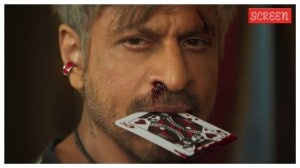Lala Amarnath was the original rebel who paid the price
In his memoirs, `Farewell to Cricket', Sir Don Bradman, writing about his last season in international cricket, recalled: "... the se...

In his memoirs, `Farewell to Cricket’, Sir Don Bradman, writing about his last season in international cricket, recalled: "… the season with him (Amarnath) as my opposite number was one of my most pleasant cricket years." That was the season Australia hosted India which had Lala Amarnath as the captain. Describing Amarnath, Bradman said, "He was such a splendid ambassador that it makes it all the more difficult to understand his recent suspension by the Indian Board of Control… ." The Don was referring to Lala’s suspension in 1949, which was revoked soon after.
Cricket, especially Indian cricket, these days lacks characters. But it was not so, when the likes of Lala were around. Outspoken to the point of being offensive, a man who consistently called the spade a shovel and who cared little about the consequences before letting loose a flyer.
When his second son, Mohinder, called the selectors a bunch of jokers, it was easy to see where the genes had come from. And long before Mohinder became the `Comeback Man of Indian cricket’, his father had staked claims to that title.
None before him or none since took on the authority with such impunity as he did. He played with fire and he got burnt, but never complained. He played his cricket hard, fought his personal battles harder and was never averse to paying back in the same coin.
The original rebel, as many described him, did not walk out of the 1936 Tour, but was actually sent back for disciplinary reasons. Livid at being denied the opportnunity of playing himself back into form against a weak Minor Counties during the period he was out of form, Lala lost his cool at the then skipper Maharaja of Vizianagram. He had started the tour in a spectacular manner and had 591 runs in 19 inings and taken 32 wickets, but then his form slumped. Against Minor Counties, he was padded up for better part of two days and others were sent ahead of him. He went in at No.7 and barely played for a few minutes when it was stumps. He came back, abused Vizzy in choice Punjabi, flung his bat around and took out his ire on another Indian official.
Following a complaint from the official, Lala was asked to pack his bags and leave the same evening within hours of the match finishing. An appeal from fellow players like CK Nayudu, Nissar, Wazir Ali among others resulted in Vizzy relenting, but the manager, Brittain Jones, a man chosen by the Viceroy, did not and India’s best player went back without playing a Test on the Tour.
More than a decade later, Amarnath fought his way back into the team and became the first cricket captain of Independent India. But within a year or so, he was again in trouble. Interestingly, it was Anthony D’Mello, who was instrumental in Amarnath becoming the captain in 1948, but now the same D’Mello was at the receiving end of Lala’s ire, who wanted more money and better facilities for Indian cricketers.
Indians travelled by train, and stayed in cheap hotels while visiting teams got the best of facilities. Lala protested against this and got the boot for it, as the Board in a meeting suspended him for misbehaviour and breach of discipline. An apology got him a reprieve, but he lost his captaincy when England came to India in 1951-52.
Despite losing his place for the tour of England in 1952, Lala made a dramatic comeback and that too as the captain when Pakistan came to India in 1952. But the series was not without politics. It was to be his last series. As recorded by Mihir Bose in his "A History of Indian Cricket", Amarnath, who had not forgotten what Vizzy did to him in 1936, got up and spoke with vengeance at the dinner after the last Test. "I have been taught to play cricket in a bad school. Vizzy will bear me out, and since 1936, and since he he has become a member of the Board of Control, he has not played cricket. I know he is a responsible man, but he plays other games than cricket on the Board," he said.
Amarnath was not chosen for the next trip to West Indies and his career came to an end. The potential was immense. But it was never really fulfilled, notwithstanding the century in 1933, which was also the first by an Indian and one which saw Indian women present him their jewellery in appreciation. The figures will never tell the true story, for he played 24 Tests and scored just 878 runs and took 45 wickets. Lala, actually, was worth much more.
A rough uncut diamond, he may have been. But scored just 878 runs and took 45 wickets.
- 01
- 02
- 03
- 04
- 05





























